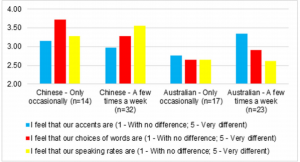7 Intercultural Practice In a University Library
Students in the Capstone unit ‘Intercultural Practice’ contributed these marvelous works based on their research projects in August to November 2021.
In this chapter, Amritpal shares her research on the Intercutural Practices observed as a student user of CDU library.
Amripal Kaur
Discussion paper; To what extent can libraries promote generative interaction among culturally different students?
Introduction
Effective intercultural communication is a priority of everyone’s life as urbanisation, international study exchange, international business and travel the contact between culturally different people has been increased. The purpose of this paper is to discuss that how libraries can promote generative interaction among culturally different students. I have chosen CDU library for this discussion because I spend most of my time in this library these days, and I was curious to explore library as an intercultural communication place. I usually visit library for the study purposes only, however, this discussion paper will provide that library can be a space where people can have generative interactions. This document will first discuss the contextual features, which is mainly focus on the structure of the library and how students interact at different levels/floors of the library. Secondly, the theory of Generative Interactions will be discussed in the context of communication at library and this paper will discuss an empirical studies that why international and domestic students hesitate to interact with each other. The third section of this document will be focused on some barriers to effective intercultural communication and significant strategies for both individual and organisation level will be provided to overcome these challenges and to produce effective and generative interactions at the library.
Contextual features
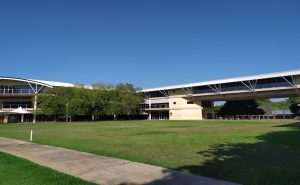 |
The library is situated in Charles Darwin University (Casuarina campus). The entire library is a non-smoking area, and it is a three-story building. The following paragraphs will discuss the physical environment of each floor of library.
Ground floor
The ground floor consists of two main doors for entrance and there is third fire exit door. The first main door is near the car park and there are wood desks near this entrance where usually students (including me) sit before or after the library hours or to have their meals as well. The circulation desk and the reference desk are on the right side of the main entrance where students can see the library staff for any assistance associated with the library. There are nearly 60 computers on the ground floor of the library, and these computers have been set-up on big round tables (4-6 computers on each table), where students can do both individual and group study.
Library foyer is next to the second entrance of library. The library foyer constitutes of three doors from different direction and the fourth door attached this foyer to the library. There are comfortable couches available in this space, where students usually sit and interact with each other. Furthermore, there is an interactive screen in the library where students can read and watch videos about the history of Charles Darwin University. Overall, students interact to a greater extent on the ground floor of library.
Second Floor

People can access the second floor (or Level 2) via lift or stairs and there is a fire exit as well. On the second floor, there is computer lab with nearly 25 computers which CDU students can access. There are only two computers outside the computer lab which students can use only to search for the library catalogue. There are nearly 20 large book stacks, where books are arranged by call number and are often easy to find as the books are always arranged perfectly by the library staff.
There are approximately 60 desks set up in two sides of the book stacks for individual studies, whereas there around 10 tables for group studies. Students who sit around the group study table, or the study room often interact with each other whereas students studying individual often just concentrate on their study and avoid communication. There is an outside area on this floor which is often used by students to have their food, to attend phone calls or to relax as well. Overall, few students interact with each other on the level 2 of library, whereas other prefer to focus on studies only, hence avoid speaking.
Third floor
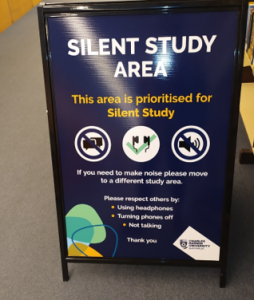
The third floor of the library is the silent study space and when you entered in this floor there is a big board which states that the third floor is prioritised for silent study (as shown in the image). Therefore, students often avoid speaking in this area, however there are times when students talk to each other very quietly.
On this floor, there are three group study room for 8 to 16 students and these rooms are wide enough to adjust this number students. Additionally, there is a separate study area which is only accessible to the Higher Degree by Research students. There is also staff room for library staff. There are around 50 desks set-up for individual study and no food or drink is allowed in this space and phone must be on silent and no one is allowed to attend phone calls inside the silent study space, however sometimes students do answer their phone calls, but the conversation is often less than two minutes.
There is a big space on this floor- separate from the silent study area, where students can interact freely and there are big round tables, chairs and white boards are available which often assist students for group studies. In addition to this there is a balcony, where students often go to have their meals and enjoy the natural views. I sometimes go in this space to relax and to see the sunset view for a few minutes.
There are toilets and drinking water accessible at each floor of the library. Furthermore, there are emergency evacuation charts and emergency phone available at various places. Due to COVID-19 there are several hand sanitizing spots, and everyone is required to log in before they enter in the library. In addition to this, the entire library building is a smoke free area, and people will be denied access to the library if they smoke in non-smoking areas. Following are some pictures that I captured from CDU library, these are associated with the emergency planning, COVID-19 precautions and warning for not to smoke in or near the library.
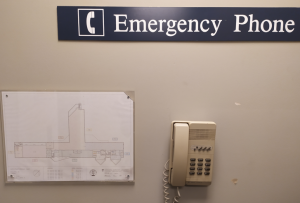
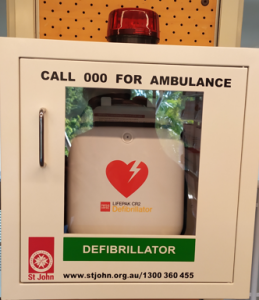


Theory and Frameworks
For culturally effective communication it is importance to understand that inclusion and equity are inevitable components of effective intercultural communication (Bernstein et al., 2019). However, exclusionary dynamics such as self-segregation, communication apprehension, stigmatizing and stereotyping can restrict inclusion and effective and generative communication. The theory of Generative Interactions outlines that to facilitate inclusion these exclusionary practices must be overcome through skill development and adaptive cognitive processing (Bernstein et al., 2019). Furthermore, the theory of Generative Interaction suggests that engagement in positive interactions is also imperative to facilitate inclusion and organisations should initiate and elevate practices that can assist stakeholders to move from diversity towards equity and inclusion (Bernstein et al., 2019). I believe that CDU library specifies some organisational practices such as group study spaces, free meals during exam weeks etc which facilitate and sustain generative intercultural interactions which eventually lead to inclusion and equity.
The library, an Intercultural place?
People might visit library to find information, however they find each other as well, which provides opportunities for meeting and conversation. It is irrefutable that library reinforces the social connections, however it can also bridge connection between people that normally do not have contact with each other (White & Martel, 2021). I explored library as a place which facilitates various meaningful interactions, it is also essential to understand the potential of library as an intercultural meeting space. The concept of interculturalism in library often associated with the notion of intercultural competencies, which can be summarised as “Knowledge of others; knowledge of self; skills to interpret and relate; skills to discover and/or to interact; valuing other values, beliefs, and behaviours; and relativising oneself. Linguistic competence plays a key role” (Byram, 1997 as cited in Deadroff, 2006). Knowledge of different cultures, mutual respect and negation are important aspects of culturally appropriate communication (Purtilo & Haddad, 2002 as cited in O’Toole, 2008).
Communication barriers for students
International students who have been previously educated in different social and cultural backgrounds from their domestic peers, acquire low willingness to communicate in English due to the fear of faulty impression and being unfavourably judged by others. Yo Tim God and Hangzhi Zhang (2018) conducted a survey among Chinese and Australian students regarding their understanding and experience of intercultural communication at an Australian university. In general, both groups respond that intercultural communication was often

interesting and useful, around 40% of Chinese survey participants indicated that communication with Australian peers can be difficult and stressful, a similar percentage of Australian participants reported that chatting with Chinese was likely to be difficult and confusing. Lack of language and common cultural grounds was found to be the major reason behind this issue.
|
This study finds that students acquire knowledge of language and cultural differences, however they were unaware about the subsequent challenges. Which implies that have less intercultural norms and they often referred to intracultural norms while dealing with communication barriers. As students were constrained by intracultural norms, the quality of intercultural norms was likely to be affected. An undesirable outcome such as fear of unfavourably judged by others, could reduce their motivation for intercultural communication.
This study recommends that promoting benefits of intercultural communication is not enough, however universities should also establish some intercultural norm so that students can avoid intracultural constraints. Consequently, they could effectively use the communication strategies and subsequently enjoy higher quality communication.
Strategies
Avoid stereotypical judgement
Personal assumptions and limited information about person/s from different cultural or social group often lead to the development of stereotypical attitudes (Amerning, 2011, as cited in O’Toole, 2012). These stereotypical judgements based on biases and prejudices can negatively affect culturally competent communication and can result in misunderstanding, conflict, and communication breakdown (Mohan et al., 2008). In order to communicate positively and effectively with people from different backgrounds, it is necessary to overcome the biases and prejudices that lead to stereotypical judgements (Milliken & Honeycut, 2004). During communication, especially in situations of intercultural interactions, it is important to accept and appreciate diversity (Egan, 2010). This diversity mandates the requirement for culturally competent communication. To achieve cultural competence, one should understand that culture differs, and each individual has unique identity with diverse experiences, worldviews, values, beliefs and attitudes. Dean (2001) argues that one cannot be ‘completely culturally competent’ in every culture unless born into that culture, however being aware of, sensitive to and appreciative of cultural variations can assist people to have positive communication. To be culturally competent it is necessary to gain knowledge about different cultures (Devito, 2009). I believe that interacting with more culturally diverse people will improve the level of my cultural competence.
Ethnocentrism and self-awareness
Moving further, in terms of intercultural communication, ethnocentric attitude (belief that one’s own culture or ethnic group is superior to other cultures or ethnic groups) is a common phenomenon which can resist people to explore other cultures which can negatively affect communication (O’Toole, 2012). The concept of self-awareness is inevitable to overcome this communication barrier. The critical evaluation of personal and individual cultural values, beliefs and traditions is the essential step to achieve culturally competent communication (Balcazar et al., 2009). Seeking exposure to people who are culturally different with an open and accepting attitude is lucrative in overcoming the issue of stereotypical judgements (O’Toole, 2012). I personally should change my attitude towards communication, I do not have ethnocentric attitudes, however interaction with different people will assist me to develop perception based on experience and it will assist me to understand that variations exist within any grouping, and everyone is unique regardless of their ethnicity or societal norms. Therefore, in order to have generative and culturally competent communication with culturally different people it is vitally important to not to develop negative personal assumption about them and exposure to particular groups or people is equally important to understand the cultural variations and to generate intercultural communication.
Exposure to learning
The best way of effective intercultural communication is to gain knowledge about different cultures (Devito, 2009). There are several ways to gain this knowledge such as, reading books, articles, e-book associated with the culture, watching relevant movies, communicating with friends from the culture etc. Another effective method to learn about different cultures is to approach person/s from other culture with a positive attitude (Seth, 2010). In libraries, however, students avoid intercultural interactions. One way to encourage students to communicate with culturally different people is to create a separate space where students can put images, pamphlets, notes associated with their own culture. When student will visit that space, they not only will share their own cultural heritage but also familiarise their selves to other cultures. It is highly likely that they will ask questions about culture and traditions to other culturally different students which will enhance their understanding and knowledge of other cultures and eventually produce appropriate and sufficient skills for culturally competent communication.
Anticipation of difficulties
O’Toole (2012) states that there are several difficulties that can occur during any communication, however, anticipation of these difficulties can assist people to respond appropriately. There are different methods to overcome difficulties associated with the culturally appropriate communication which involves gaining knowledge of that culture, being aware of personal cultural attitudes and understand factors of culturally appropriate communication. Another initiative could be an outreach-type approach to welcome and include people from immigrant background, mainly new students, by developing activities to promote intercultural rapprochement and intercultural component should be developed in library services (White & Martel, 2021)
Conclusion:
Overall, library can produce generative interactions amongst students, with students own willingness and with some organisational changes as well. CDU library is perfectly structured and provide several spaces for those who want to interact with each other, and some students visit library for serious studies only and CDU library provide adequate spaces to those students as well. The students studying at Charles Darwin University came from all around the globe, hence they have diverse cultural values and norms. International and domestic students avoid communication with each other, not only due language barriers but also due to the difference in cultures. However, students who hesitate, should change their attitude towards intercultural communication and should be culturally competent and self-aware to have positive outcomes form cross-cultural communication. They should not have stereotypical or ethnocentric attitudes, rather they should learn different cultures through communicating each other. Additionally, library as an organisation should also take greater responsibility to encourage students towards generative intercultural communication. Library staff should introduce new activities in which student can share their culture and can also learn other cultures as well. Overall, CDU library promotes generative intercultural interactions, however more efforts, from both students and staff is required for further improvements and enhancement in these interactions.
References
Bernstein, R. S., Bulger, M., Salipante, P., & Weisinger, J. Y. (2019). From Diversity to Inclusion to Equity: A Theory of Generative Interactions. Journal of Business Ethics, 167(3), 395–410. https://doi.org/10.1007/s10551-019-04180-1
Balcazar, F. E., Suarez-Balcazar, Y., & Taylor-Ritzler, T. (2009). Cultural competence: Development of a conceptual framework. Disability and Rehabilitation, 31(14), 1153–1160. https://doi.org/10.1080/09638280902773752
Deadroff, D.K. (2006). Identification and Assessment of Intercultural Competence as a Student Outcome of Internationalization. Journal of Studies in International Education 10(3), 2410266, https://doi.org/10.1177/1028315306287002
Dean, R. G. (2001). The Myth of Cross-Cultural Competence. Families in Society, 82(6), 623–630. https://doi.org/10.1606/1044-3894.151
DeVito, J. A. (2012). The interpersonal communication book (13th ed.). Pearson.
Egan, G., & Egan, G. (2010). The skilled helper: a problem-management and opportunity- development approach to helping (9th edition.). Cengage Learning.
God, Y. T., & Zhang, H. (2019). Intercultural challenges, intracultural practices: how Chinese and Australian students understand and experience intercultural communication at an Australian university. Higher Education, 78(2), 305–322. https://doi.org/10.1007/s10734-018-0344-0
Milliken, M. A & Honeycutt, A (2004). Understanding human behaviour: A guide for healthcare providers (7th edn). New York.
Mohan, T. (2008). Communicating as professionals (2nd ed.). Thomson Learning Australia.
Seth, T. (2010). Communication to pediatric cancer patients and their families: A cultural perspective. Indian Journal of Palliative Care, 16(1), 26–29. https://doi.org/10.4103/0973-1075.63131
O’Toole, G. (2012). Communication: Core Interpersonal Skills for Health Professionals. Elsevier Australia.
White, B., & Martel, M. D. (2021). An Intercultural Framework for Theory and Practice in Third Place Library. Public Library Quarterly (New York, N.Y.). https://doi.org/10.1080/01616846.2021.1918968
Final report:
Task- Complete a full report on the Intercultural Practice Experience which provides an analysis of the application of theory to practice and suggestions for change and/or improvement.
Introduction
Effective intercultural communication is an essential requirement for everyone in this modern era. This purpose of this essay is to discuss that how libraries can promote generative interaction among culturally different students. I have chosen CDU library for this discussion because I spend most of my time in this library these days, and I was curious to explore library as an intercultural communication place. This essay is divided into three sections. The first section will discuss the history and physical environment of CDU library. In addition to this my observations and perspective regarding CDU library will be discussed in this section. The second section will explore the theory of Generative Interactions and the exclusionary dynamics (self-segregation, communication apprehension, and stereotyping) and organisational practices introduced by this theory. The third section will discuss my three observations associated with generative interactions at CDU. The last paragraph will conclude this essay.
Section-1 CDU library
History and Background
Charles Darwin University is the first and only university in the Northern Territory (Australia) and it was established in 1989. CDU has invested in its campus library for the purpose of providing traditional (print) and electronic information resources, services, and facilities to support students’ information needs. The construction of the CDU library began in 1992. The Federal Minister for Employment and Training Kim Beazley opened the library in 1993.
CDU library provides several services including, free Wi-Fi, quite study spaces, online and print forms of various academic resources, opportunity to request item from another libraries, onsite café, eResources etc. Beside these services CDU library also provides a safe space where people, particularly students from diverse cultural background can have positive interactions with each other.
Physical Environment
The CDU library is divided into three floors, which are described in the following paragraphs.
Ground Floor
The ground floor constitutes two main doors and a fire exit. Anyone entering the library requires to sign in through either scanning code on their mobiles phones or by filling the COVID-19 Declaration form, which are available at both of the doors. The first door is near the main car park and there are wooden desks near this entrance, which students often use to have their meals of for group discussion as well. The circulation desk and the reference desk are on the right side of the main entrance where students can see the library staff for any assistance associated with the library. There are nearly 60 computers on the ground floor of the library, and these computers have been set-up on big round tables (4-6 computers on each table), where students can do both individual and group study.
Library foyer is next to the second entrance of library. The library foyer constitutes of three doors from different direction and the fourth door attached this foyer to the library. There are comfortable couches available in this space, where students usually sit and interact with each other. Furthermore, there is an interactive screen in the library where students can read and watch videos about the history of Charles Darwin University. Overall, students interact to a greater extent on the ground floor of library.
Second floor
People can access the second floor (or Level 2) via lift or stairs and there is a fire exit as well. On the second floor, there is computer lab with nearly 25 computers which CDU students can access. There are only two computers outside the computer lab which students can use only to search for the library catalogue. There are nearly 20 large book stacks, where books are arranged by call number and are often easy to find as the books are always arranged perfectly by the library staff.
There are approximately 60 desks set up in two sides of the book stacks for individual studies, whereas there around 10 tables for group studies. Students who sit around the group study table, or the study room often interact with each other whereas students studying individual often just concentrate on their study and avoid communication. There is an outside area on this floor which is often used by students to have their food, to attend phone calls or to relax as well. Overall, few students interact with each other on the level 2 of library, whereas other prefer to focus on studies only, hence avoid speaking.
Third Floor
The third floor of the library is the silent study space and when you entered in this floor there is a big board which states that the third floor is prioritised for silent study (as shown in the image). Therefore, students often avoid speaking in this area, however there are times when students talk to each other very quietly.
On this floor, there are three group study room for 8 to 16 students and these rooms are wide enough to adjust this number students. Additionally, there is a separate study area which is only accessible to the Higher Degree by Research students. There is also staff room for library staff. There are around 50 desks set-up for individual study and no food or drink is allowed in this space and phone must be on silent and no one is allowed to attend phone calls inside the silent study space, however sometimes students do answer their phone calls, but the conversation is often less than two minutes.
There is a big space on this floor- separate from the silent study area, where students can interact freely and there are big round tables, chairs and white boards are available which often assist students for group studies. In addition to this there is a balcony, where students often go to have their meals and enjoy the natural views. I sometimes go in this space to relax and to see the sunset view for a few minutes.
My Perspective and observations Respect for Diversity
Valuing fairness and promoting respect are the major components of CDU Code of Conduct (2021). I visit library on regular basis since past two years, and from my conscious and unconscious observations I find that library supports personal productivity and cultural engagement. Students talk to each other and have equal access to library services irrespective of their race, ethnicity, or nationality. Furthermore, the physical environment of this library plays an imperative role in promoting diversity. For example, on each floor, there are different paintings which represents different cultural groups, cultural identities etc. These paintings are a great source to learn or to begin learning about a different culture. There are images which represent Aboriginal Australian history, and it is highly useful tool to acknowledge and respect diversity.
Generative interactions
The CDU library provides a culturally safe space for everyone, especially for students to interact with each other. CDU library provides classes and several discussion sessions) for students, which promote generative intercultural interactions amongst them. Furthermore, the library staff is very friendly and cooperative, which directly influence the student-librarian interactions. Being an international student, I also used to hesitate to communicate with the librarians, however, at present I am confident to interact with any of the staff member as I know that they are welcoming and cooperative toward students. Additionally, Library also plays a vital role as a community gathering space, as people could come, sit, talk, and read. I observe that many individuals come to library and enjoy reading and talking to each other, as this is a comfortable facility for people which provide them the opportunities for social interactions.
As clear from the above discussion, my perspective of library is very positive, especially when considering cultural diversity and inclusion and equity of all students. This will be discussed throughout the essay.
Section 2- Theory of Generative Interactions
The theory of Generative Interactions proposes that inclusion and equity are inevitable components of effective intercultural communication, whereas exclusionary dynamics such as self-segregation, communication apprehension, stigmatising and stereotyping can resist inclusion and generative interactions (Bernstein et al., 2019). This outlines that to facilitate inclusion these exclusionary practices must be overcome through skill development and adaptive cognitive processing (Bernstein et al., 2019). Beside emphasising personal efforts to facilitate inclusion and generative interactions, this theory suggests that organisations should initiate and elevate practices that can assist stakeholders to move from diversity towards equity and inclusion.
Exclusionary dynamics: Self-Segregation, Communication Apprehension, and Stereotyping
To examine and understand the theory of Generative Interactions it is essential to understand the exclusionary forces to avoid disengagement in interactions and miscommunication in an intercultural context. The exclusionary dynamics such as, self-segregation, communication apprehension, and stereotyping are the major explanation of why diverse interactions are sparse and superficial. This section will expand on these terms in the context of library and how these exclusionary forces can impact on interactions among students from diverse cultural backgrounds.
Self-Segregation
Self-segregation can be defined as the social separation of a religious or ethnic group from the rest of the society by the group itself. This can lead to inability from a normal social interaction and social exclusion. Research has shown that individuals are attracted by others who they perceive as similar, this phenomenon is described as homophily in sociological culture (Stark & Flache, 2012). Homophily is a significant reason of distancing between racial and ethnic groups (Bernstein et al., 2019). As at CDU library students from diverse cultural backgrounds study; self-segregation and homophily can be major barriers to the generative interactions among students.
Cross-cultural Communication Apprehension
Neuliep and McCroskey (1997) defined Intercultural Communication Apprehension as “the fear of anxiety associated with either real or anticipated interaction with people from different groups, especially different cultural or ethnic groups.” ICA amongst international students decreases the sense of belonging and inhibits the development of social connectedness”. Neuliep (2012) provides the hypothesis that international students experience a low level of ICA in anticipated interactions with each other, as compared to international students anticipating interactions with domestic students. Bernstein and colleagues (2019) suggested that organizations should propose activities which aid in reducing anxieties and distancing, more comfort in interactions which will assist individuals to become more skilled in intercultural communication.
Stereotypical and Stigmatizing
Personal assumptions and limited information about person/s from different cultural or social group often lead to the development of stereotypical attitudes (Amerning, 2011, as cited in O’Toole, 2012). These stereotypical judgements based on biases and prejudices can negatively affect culturally competent communication and can result in misunderstanding, conflict, and communication breakdown (Mohan et al., 2008). In order to communicate positively and effectively with people from different backgrounds, it is necessary to overcome the biases and prejudices that lead to stereotypical judgements (Milliken & Honeycut, 2004). During communication, especially in situations of intercultural interactions, it is important to accept and appreciate diversity (Egan, 2010). This diversity mandates the requirement for culturally competent communication. To achieve cultural competence, one should understand that culture differs, and each individual has unique identity with diverse experiences, worldviews, values, beliefs and attitudes. Dean (2001) argues that one cannot be ‘completely culturally competent’ in every culture unless born into that culture, however being aware of, sensitive to and appreciative of cultural variations can assist people to have positive communication. To be culturally competent it is necessary to gain knowledge about different cultures (Devito, 2009). I believe that interacting with more culturally diverse people will improve the level of my cultural competence.
These three psychological and socio psychological phenomenon- self-segregation, cross cultural communication apprehension, and stereotypical judgements, has been identified as the major challenges for organization to facilitate and promote generative interaction in a cross-cultural environment. To overcome these issues at an organizational level, the theory of Generative Interactions provides some particular organizational practices to promote generative interactions:
- Organizational practices should be designed in a way which promote prejudice reduction and adaptive contact among diverse individuals.
- The organizational practices that sustain adaptive contact among individuals should operate as a set.
- Organize repeated interactions amongst diverse individuals through community building activities. This can include physical and virtual space design that enables interaction across cross-cultures.
- Repeated interaction opportunities with high frequency.
- Collaboration with members and valuing and individual member’s uniqueness and belonging.
- Ensuring interpersonal comfort and self-efficacy
Together, these precepts demonstrate the centerpiece of the Theory of Generative Interactions. The CDU library acquires some of these practices which will be discussed in the following section.
Section 3- Observations
Observation-1 Intercultural Communication and Orientation Week at CDU
Intercultural communication competence is intricately linked to individuals’ intercultural transformation, specifically their cultural adaptation (Kim, 2005). Cross-cultural adaptation is “the dynamic process by which individuals, upon relocating to new, unfamiliar, or changed cultural environments, establish a and maintain relatively stable, reciprocal, and functional relationship with those environments” (Kim, 2001). Young Yun Kim proposed the theory Cross-Cultural adaptation which refers to the process and time it takes a person to assimilate to a new culture. This theory states that communication is indispensable to bridge the gap between the individual and the environment in the adaptation process, in other words, cultural adaptation thrives and expands through international arrivals’ interaction with the locals of the host culture (Kim, 2001). Therefore, universities are required to organize activities to facilitate and maintain positive interactions amongst students. Additionally, students, especially students from other nations, should also be prepared for change and must acquire self-awareness to avoid any conflict in intercultural communication. Interactions amongst domestic and international group of students, can enable international students to gain information about native cultures’ language, viewpoints, everyday expectations, and customs (Andrew & Henze, 2009), which significantly assist international students to acquire tools required to further their adaptation to the new culture.
The orientation week at CDU library before the commencement of each semester makes it easier for students to begin or improve their cross-cultural adaptation. The CDU Code of Conduct states that staff are required to ensure that equality of opportunity is achieved through inclusiveness and respect for differences between people and actively promoting diversity. Besides introducing the campus facilities, the main purpose of this orientation week is to promote communication amongst students. There are several activities throughout the Orientation week such as welcome party for new students, campus tour, preliminary lectures, interaction time etc. which encourage students to communicate with their fellow-beings and CDU staff members without any hesitation. Orientation week is an exciting time for students to make new friends and produce generative interactions as well.
Observation-2 Social Capital and Opportunities to meet at CDU library
I believe that CDU library provides opportunities for the creation of social capital as it provides resources and opportunities for students to meet, share their thoughts and interact with each other. Social capital can be defined as one’s ability to gain, maintain, or transfer resources to improve their life or lives of others (Johnson, 2012). Social capital also refers to the glue or grease of relationship amongst people and value derived from interactions amongst people (Hill, 2009). Griffs & Johnson (2014) state that libraries create social capital by facilitating meetings, providing opportunities for people to share and interact, and also by integrating new visitors and residents and symbolising local identities. They further quoted Cotton Dana, who in 1902 defined library as the centre of activities for in a city, which contribute more to bind people than any other institution. Miller (2014) argue that interactions between library users can generate social capital by reducing isolation, building trust, and assisting people to develop their skills such as cross-cultural communication etc.
Griffis & Johnson (2014) suggested that with the power to connect citizens and increase social capital comes the responsibility to remain inclusive and open to all people and avoid biases or discrimination against individuals or materials and their representation in the library. Librarian should remain aware of an actively dismiss practices that exclude any population, especially traditionally marginalized or targeted groups within a community. CDU Code of Conduct (2021) states that CDU as an organization value of opportunity and celebrate diversity. CDU staff recognize and support people from all ethnic, cultural, and social backgrounds. From my experience of the past two years, I observed that most of the activities at the CDU library and at Charles Darwin University promote diversity. All students are equally welcome, in fact there are several activities throughout the year which are associated with diverse cultural representation through artwork and all students are encouraged to display their culture and learn about other cultures as well.
Observation-3 Personalized or Group Session to overcome communication barriers
There are several barriers for effective cross -cultural communication however, research showed that the major difficulty for international students in connecting with local communities is language proficiency. Wang and colleagues (2017) looked at the reasons of lack of interactions among domestic and international students at an American university and found out that approximately 40% of students surveyed avoid communication with local students due to lack of English proficiency.
To assist students to overcome language barriers, the CDU library provides language learning classes. These classes help students to improve their English language skills through interacting with other students without any hesitation. I usually attend these classes; it is often about 2 hours long and hosted by an academic expert. The first 45 minutes are for students to introduce themselves and then interact with each other regarding different topics such as diversity, inflation, political issues, study experiences or other global issues. After that, the academic staff teach the students about different communication skills such as intonation, gestures, and body language, socializing, slang/cultural references, confidence etc. Before the end of each class, students play games which consequently teach students to how to interact appropriately in different situations. Not only this, but students are also encouraged to interact with each other via social media or face to face meetings, this is an effective initiative of CDU library to promote cross-cultural and generative interactions. Students can book several sessions during the semester which eventually provides opportunity for students to have generative interaction, as the organisations are required to provide repetitive opportunities to promote generative interactions (Bernstein et al., 2019).
Conclusion
Overall, CDU library has been identified as a culturally safe space for facilitating and maintain generative interactions. The theory of Generative Interactions provides some barriers to intercultural communication including communication apprehension, and stereotyping, however, the CDU library overcome all these exclusionary dynamic by having an effective Code of Conduct (2021) and organizational practices in place. CDU library provides numerous opportunities such as orientation week, group discussion etc for students which promote inclusion and equity amongst diversity. Overall, CDU library is a culturally safe space for everyone to begin and sustain generative interactions.
References
Andrews, D. C., & Henze, B. (2009). Teaching professional writing to American students in a study abroad program. Business and Professional Communication Quarterly, 72(1), 5–20.
Bernstein, Bulger, M., Salipante, P., & Weisinger, J. Y. (2019). From Diversity to Inclusion to Equity: A Theory of Generative Interactions. Journal of Business Ethics, 167(3), 395–410. https://doi.org/10.1007/s10551-019-04180-1
Charles Darwin University, (2021). Code of Conduct. https://www.cdu.edu.au/governance/doclibrary/cod-004.pdf
Griffis, M.R., & Johnson, C.A. (2014). Social capital and inclusion in rural public libraries: A qualitative approach. Journal of Librarianship and Information Science, 46(2), 96- 109.
Johnson, C. A. (2012). How do public libraries create social capital? An analysis of interactions between library staff and patrons. Library & Information Science Research, 34(1), 52–62.
Kim, Y. Y. (2001). Becoming intercultural: An integrative theory of communication and cross-cultural adaptation. Thousand Oaks, CA: Sage.
Kim, Y. Y. (2003). Adapting to an unfamiliar culture: An interdisciplinary overview. Thousand Oaks, CA: Sage. 50
Kim, Y. Y. (2005). Adapting to a new culture: An integrative communication theory. Theorizing about intercultural communication. 375-400.Oaks, CA: Sage.
Kim, Y. Y., & Mckay-Semmler, K. (2013). Social engagement and cross-cultural adaptation: An examination of direct- and mediated interpersonal communication activities of educated non-natives in the United States. International Journal of Intercultural Relations, 37(1), 99- 112.
Miller, J. (2014). A comparative study of public libraries in Edinburgh and Copenhagen and their potential for social capital creation. Libri 64(4): 316−326. DOI 10.1515/libri- 2014-0025
Media Attributions
- cdu library 1
- cdu library 2
- cdu library 3
- cdu4
- cdu5
- cdu6
- cdu7
- cdu10
- cdu9

